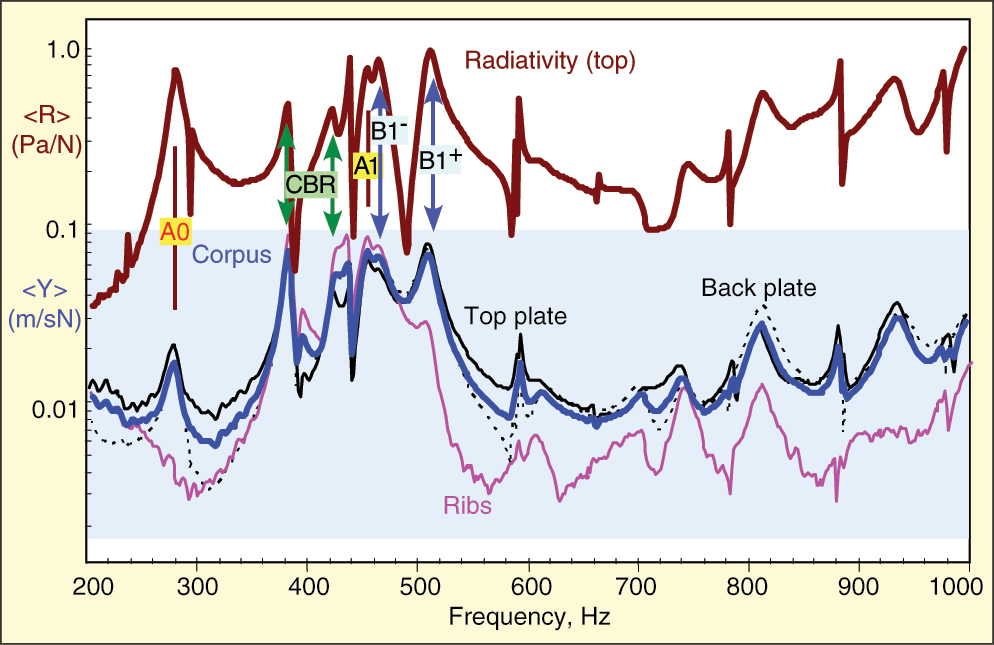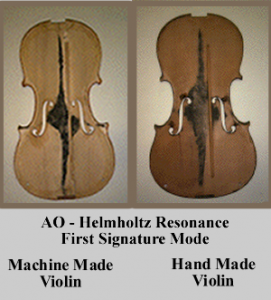“AO – is the abbreviation for the “air mode” of a violin. This mode is a Helmholtz resonance, involving air flow in and out of the f-holes, however, modified by the fact that the walls of the box are not rigid so that some breathing motion of the box also occurs. A0 is usually found around 280 Hz in a violin.” [1]
There seems to be a pre-conceived notion among many string teachers that the fastest way for a student to achieve a better tone is to purchase a better quality instrument. [2] To some extent this is true; when the student advances musically, the natural progression is for him to invest in a higher quality instrument. However, when teaching a class of beginners–most of whom are playing on rental factory-made instruments–it is important to recognize that within the open G, D, and A string first position register, the vibrational response of all violins is basically the same. This simply means that every violin has the same ability to vibrate in this register, and knowing that tone quality is “determined by the amplitudes [size] of the harmonics which are present,” the ability to produce the largest size of vibrating harmonics can be taught, regardless of the instrument’s quality. [3]
The notion that a machine-made violin from a Chinese factory has the ability to vibrate the same, therefore the ablity to produce a quality tone as does a Cremonese instrument hand crafted in the 1800s, is an idea that for many, strains the limits of credibility. But as illustrated by the studies described below, the science has consistently proven such a claim.
Ernst Chladni: The Father of Acoustics (1756–1827)
The study of the physics of sound and tone production dates back to 1787 with the work of Ernst Chladni. His work involving the vibration of plates has served as the foundation of many experiments by other scientists. Chladni’s study consists of vibrating a fixed, circular plate with a violin bow, and then sprinkling fine sand across the plate to show the various modal lines and patterns resulting from the vibration. Whenever Chladni demonstrated his findings in royal academies and scientific institutions, he frequently drew large crowds who were duly impressed with the aesthetically sophisticated qualities of vibrating plates. Napoleon himself was so pleased with Chladni’s work, that he commissioned further study of the mathematical principles of vibrating plates, which then spurred a plethora of research in waves and acoustics. While experimental methods and equipment have been much improved in the last 200 years, Chladni’s law and original patterns are still regularly employed to study plate vibrations. [4] These patterns are repetitive and distinct, serving as visual representation of sound waves. [5]
AO Signature Mode In The Violin
The first and most dominant mode in the violin is called the Air Mode, which is a Helmholtz resonance. The illustration below shows where the AO Signature Mode forms on a machine- made violin, and on a handmade violin. It is easy to see that this first mode is one of the strongest – as it covers the front center section and the area around the f-holes of the instrument. It is also easy to see that this mode is very similar in strength for both violin qualities.
The first five vibrating modes formed in the cavity and top-plate of the violin are the same in each of the two instruments, independent of their monetary value. These first five modes are called Signature Modes. [6]

Signature Modes of the Violin (Reprinted with permission from George Bissinger and David Oliver, “3-D Laser Vibrometry Laser Vibrometry on Legendary Old Italian Violins,” Sound and Vibration (July 2007):12, http://www.sandv.com/downloads/0707biss.pdf.
Physicist George Bissinger, professor at East Carolina University, has done in-depth research on the violin Signature Modes. His studies on the modal qualities of the violin show that “all violins tested showed the same five Signature Modes below 600 Hz.” [7] According to Bissinger, “the ‘robust’ quality differentiator difference was the approximately 280 Hz, Helmholtz-type AO cavity mode.” [8] Therefore, if all violins contain these same five modes within the first position string range, then it must be possible that regardless of a violin’s monetary value, if the string is engaged in Helmholtz motion, the instrument has the capability of reaching its maximum tone quality.
Reaching beyond the demonstrations of vibrating plates, Chladni’s work on acoustics has informed studies that impact the principles of modern violin-making. Co-founder of the Catgut Acoustical Society in 1963, Carleen Hutchins is best known for pioneering work in the development of acoustical scientific insights and their application to the construction of new and conventional instruments of the violin family. [9] Hutchins developed and built a series of violins, ranging from very small–producing the highest frequencies, to very large–producing the lowest frequencies. She developed a violin set-up for assessing and altering the vibrational modes using Chladni’s patterns, focusing on his first five–referred to today as–Signature Modes. These modes have the same vibrational characteristics on all violins, regardless of their origin and purchase price. [10]
In yet another study, Kenneth Marshall characterized five low-lying normal modes (Signature Modes) that contribute to the overall response in the first position string region of the violin–nominally between 196 to 600 Hz. [11] Marshall states, “these [five low-lying normal modes] have been seen for all violins tested to date, regardless of quality.” [12] Therefore, within the first position register on the violin, it should not make a difference whether a student is playing on an inexpensive, rental-quality instrument or a high-priced Cremona violin; the vibrational qualities in the wood are the same in both instruments.
Beament, Marshall, Bissinger, and Hutchins all agree that the first five Signature Modes are present, and vibrate the top plate of all violins, in almost exactly the same manner, regardless of the quality of the instruments. In the beginning strings class, this register is the starting point for all string instruments. It is then the teachers’ responsibility to help students achieve the highest tone quality from their instruments by introducing Helmholtz motion at the very first lesson. Asking a beginning strings class to only play pizzicato until their first concert constitutes a disservice to the students and is an entirely avoidable and unnecessary hardship imposed on a strings student’s musical development.
Please take a moment to review the exercises in my article, “Learn to Play With Helmholtz Motion.”
I look forward to your feedback!
—————
[1] http://www.oberlinacoustics.net/index.php?location=glossaryMain
[2] Donald L. Hamann, and Robert Gillespie, Strategies for Teaching Strings: Building a Successful String and Orchestra Program (New York: Oxford University Press, 2004), 134.
[3] James Beament, “The Vibration of Strings,” Chapter 2, in The Violin Explained: Components, Mechanism and Sound, (England: Oxford University Press, 2000), 10.]
[4] Thomas D. Rossing, “Chladni’s Law for Vibrating Plates,” American Journal of Physics 50, no.3 (March 1982): 271.
[5] Johannes Courtial and Kevin O’Holleran, “Experiments with Twisted Light: Some of the Mechanical and Quantum-Mechanical Properties of Optical Vortices,” European Physical Journal -Special Topics (June 2007): 36, http://www.physics.gla.ac.uk/Optics/papers/authorPDFs/Courtial-OHolleran- 2007.pdf .
[6] Kenneth D. Marshall, “Modal Analysis of a Violin,” Acoustical Society of America 77 (February 1985): 697.
[7] George Bissinger, “Structural Acoustics of Good and Bad Violins,” The Journal of the Acoustical Society of America 124 (September 2008): 1754.
[8] Bissinger, “Structural Acoustics,” 1764.
[9] Catgut Acoustical Society, http://www.catgutacoustical.org/.
[10] Marshall, 696.
[11] Marshall, 696.
[12] Marshall, 696.
















Hi,
I have a less expensive violin and it sounds pretty good. I am sure it would sound better with someone that knew how to play. It came with some standard strings and I noticed a remarkable difference when I changed to Thomastik Dominant strings. Have any studies been done comparing strings? Even my untrained ear noticed the difference right away.
The figure showing the first free plate mode is incorrectly noted to be the A0 motion of the assembled violin. It is impossible to see the motion in the free plates of the A0, as it takes the closed air volume of the interiour of the violin along with the f-holes to produce that resonance.
Also the text on the A0 (Helmholz resonance) in factory and hand made instruments is in general incorrect. Usually well built and old Italian violins have a stronger A0 than the usually stiff walled factory instruments.
Good Morning, i’m really interested in this kind of sound research over acoustic instruments. Can you explain to me how you induct the resonance of precise (or a group of) frequencies over the instrument?
Hi to eѵery bodү, it’s my first go to see of this
weblog; this weƄsite consists of aԝesome and actually gߋod material іn support
of visitors.
Hi there,I check your blogs named “Helmholtz Resonance Signature Mode In The Violin – String Visions” like every week.Your story-telling style is awesome, keep doing what you’re doing! And you can look our website about proxy server list.
mu88 casino – Link vào nhà cái uy tín mới nhất https://mu88-casino.org
mu88 casino – Thiên đường giải trí với hàng ngàn slot game, mini game hấp dẫn. Nạp rút nhanh chóng, bảo mật cao và khuyến mãi khủng mỗi ngày.